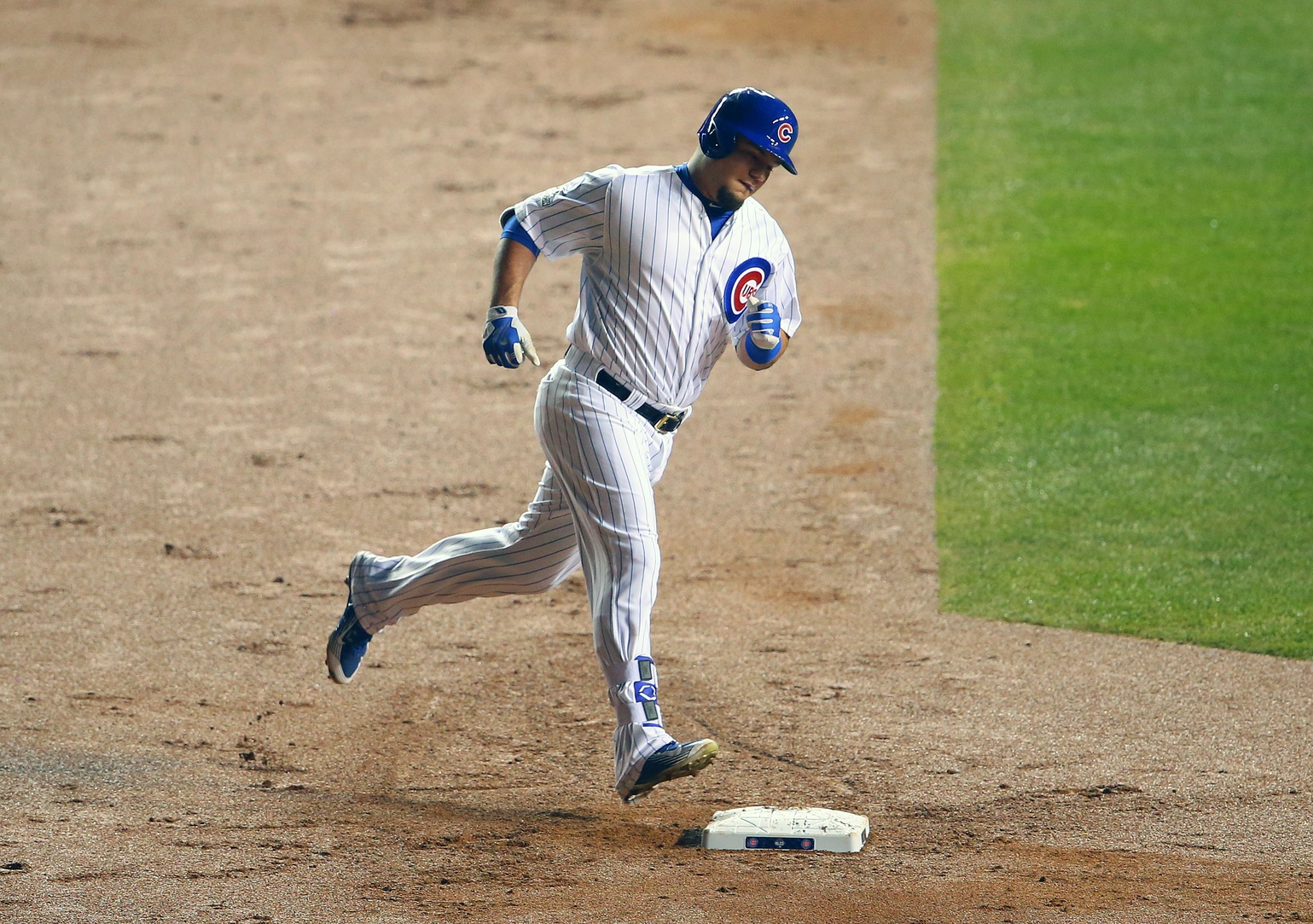Do you ever have those surreal moments when you find yourself somewhere strange, and the series of events it took to get you to that place seem unfathomable? My day job involves extensive international travel that takes me to some of the farthest regions of the earth, so this happens to me regularly: Where am I? How did I get here? A year ago, could anyone have ever predicted I’d be standing in the middle of the barren Mongolian landscape? I can’t really explain why this phenomenon happens, but I suspect it’s my way of stopping to appreciate the uniqueness of the situations I find myself in.
That feeling is the only way I can describe what it feels like to write about what I am currently writing about: Kyle Schwarber leading the 2015 Chicago Cubs in BP’s BRR (Baserunning Runs) statistic. BRR, for what its worth, measures those runs created solely by one’s efforts on the basepaths. Can that really be true? Is it possible the fine folks at BP Stats made a mistake? How did we get here? Is this legitimately a strong point of his game?
Let’s start with a quick rundown of the Cubs’ leaders in BRR, to give you some perspective on Schwarber’s prowess. Overall MLB rank in parentheses:
1. Kyle Schwarber: 3.4 (38)
2. Kris Bryant: 2.4 (64)
3. Chris Coghlan: 1.4 (111)
4. Jonathan Herrera: 0.7 (190)
5. Chris Denorfia: 0.7 (200)
That’s a very underwhelming list, when it comes right down to it. Thankfully, some help is coming, as Jason Heyward ranks as one of the best baserunners in the majors, finishing fourth overall in BRR. On the other hand, of course, there’s Anthony Rizzo, who finished 823rd out of 832 qualifying major-league players with his tally of -5.1 BRR. To put that in perspective, that’s two spots behind Yadier Molina, and two spots ahead of Pablo Sandoval. Get ‘em next year, Tony.
So, how did Schwarber do it, and in just 69 games, no less? We already know he doesn’t steal bases, as he had just three successful swipes in six attempts. That’s good for a net of -0.14 to his BRR total. He was solidly above average in air-advancement opportunities (0.21) and ground-advancement opportunities (0.48), but didn’t change the equation much with his efforts on other-advancement opportunities (passed balls, wild pitches, etc.) (-0.01). The analytical personality types out there have likely already done the math, and are aware we have a significant amount of missing runs, 2.87 to be exact.
There remains one final input to this metric—that being hit-advancement opportunities, or the moments where he took an extra base—and that’s where Mr. Schwarber did the bulk of his heavy lifting. Impressively, his 2.87 OAR rating doesn’t just rate highly among his slowly-chugging Cubs brethren, it’s also good for seventh in all of baseball. Lorenzo Cain (4.50), Brett Gardner (4.42), Alcides Escobar (4.05), Adam Eaton (3.47), Heyward (3.40) and Torii Hunter (3.20) are the only players to best Schwarber in this metric. In other words, he’s surrounded by guys with prolific speed and/or players lauded for their baseball acumen. This hints that this may be a legitimate skill, rather than a fluke.
Now, here’s a hypothesis that might be worth considering: perhaps Schwarber was able to run up his ‘hit-advancement’ score exactly because opposing outfielders weren’t expecting him to get very far, and so took a little more time against him than they might otherwise have done. If that’s the case, the league won’t take very long to figure him out, and we may see some regression next year. Or, you know, maybe he’s just good. Let’s keep an eye on it.
Something to keep in mind when considering the merits of BRR is that there is very little guesswork in the calculation of the metric. It’s one reason I find it very interesting to follow. Schwarber’s HAO success is backed up by the following hard data from 2015:
- When Schwarber was on first base, nine times a single was hit, three times he was able to reach third base.
- While on first base, a double was hit five times, four of those times he came all of the way around to score.
- Most impressively, when Schwarber was on second base, he scored 10 out of 11 times on singles.
We have to keep in mind that the sample size was small, thus there exists the possibility that chance or circumstance skewed these results—or, of course, my hypothesis from before. In many ways though, this speaks to me enough to change my personal narrative of Kyle Schwarber. He may not be just the hulking slugger that is content with eliciting a “mercy” uttering from national broadcasters. We already know his work ethic is spoken of highly by members of the Cubs front office, and this data suggests that he may contain the athleticism to become something more—perhaps much more—than he’s thought to be right now.
Lead photo courtesy Caylor Arnold—USA Today Sports.

I don’t know why you think this is so surreal. I look at Schwarber and all I see is Lofton-like speed (Kenny or James).
You look at people through the lens of beauty, my friend. Nothing wrong with that.
Imagine the best baserunner on your team being stunted in his development and max value by a David Ross.
…I hear you, but is he really being stunted? I think you could argue that any way you shake it, he wouldn’t be getting many starts at C with or without Ross.